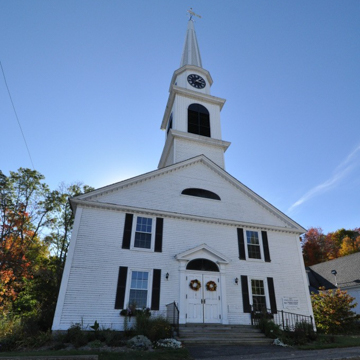Situated on the south side of Highland Street, slightly downhill from the Beede House, is the First Congregational Church, one of the town’s principal architectural landmarks. Variously known over the years as the North Church or the White House, this stately wooden structure was initially erected in 1832–1833 on Meredith Bay of Lake Winnipesaukee. It was moved to its present site in 1842. Like the Baptist Church (see BE44), it incorporates earlier Federal-style features in its semi-elliptical, end gable fan lights, round-arched side windows, and curved modillion blocks beneath the eaves. The original central tower consisted of a plain, square base, and a second belfry stage with round louvered arches and corner finials. In 1871, the finials were removed, and the current polygonal clock stage and spire were added. Recently updated were the original decorative glass and stained-glass transoms with floral designs dating from the 1870s.
Opposite and below the church, where Highland Street meets Main Street, is the former brick Neoclassical Meredith Village Savings Bank, constructed in 1925 and today the Meredith Municipal Building. Its most distinguishing feature is the front central entranceway flanked by granite Doric pilasters surmounted by a heavy entablature with thick, overhanging cornice.

